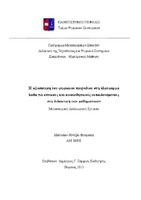Η αξιοποίηση του ψηφιακού παιχνιδιού στη πλατφόρμα Kodu για οπτικούς και κιναισθητικούς εκπαιδευόμενους στη διδακτική των μαθηματικών

View/
Keywords
Στυλ μάθησης ; Οπτικό-κιναισθητικό στυλ ; Υλικά ; Ενσώματα μαθηματικά ; Αθροιστικές στρατηγικές ; Προσθετικά προβλήματα ; Στάσεις ; Kodu ; Kinect ; Learning styles ; Embodied mathematics ; Materials ; Addition strategies ; Addition word problems ; AttitudesAbstract
the current school reality a significant percentage of students face difficulties in
understanding mathematical concepts. These difficulties may be linked with
factors that are related with the students and/or with the learning and teaching
procedures in school.
Research reports that the improvements of the textbooks, the contemporary
approaches to learning and teaching, and the teachers’ comprehensive
professional development are not sufficient for the students’ overcoming their
difficulties with Mathematics, thus resulting in their negative experiences with
this subject. Nevertheless, the existence of individual differences in the learning
process have caused the students’ being ‘trapped’ within one teaching approach,
since the curriculum and the textbooks are addressed through the various activities
predominantly to visual learners and to a lower degree to auditory learners, while
there is almost no explicit reference to kinaesthetic learners.
Even from the first school years (kindergarten) the learners are expected to be
familiarised with mathematical concepts, as they are defined through the
curriculum objectives. Their entering to primary school assumes their acquisition
of elementary mathematical concepts, since the students are required to interact
meaningfully in more complex activities.
The aim of this study was to isolate some of the aforementioned factors with the
purpose for the teaching process to be more accessible to more students and, to
evaluate the results of this intervention with respect to the learning goals, as well
as with respect to the students’ attitudes. Following these, in these study we
concentrated in the various ways of approaching a mathematical concept, the
visual transmission of the information and the embodied enacting, regarding the
nature of the subject, the students’ confidence and their appreciation of the
usefulness of Mathematics outside school.
Consequently, an educational digital game about Mathematics was designed in
Kodu with Kinect support (Microsoft) considering the following: to include activities that are in line with the curriculum objectives, to allow for and to
facilitate interaction, to reflect the learners’ learning style and to be compatible
with the learners’ age.
The game was utilised as means for facilitating the learners’ active participation
and the effectiveness of the learning process with respect to the conceptual
enactive and procedural approach of addition and addition word problems for each
of the under investigation learning styles.
The visual and kinaesthetic learners were actively involved in mentally
constructing additions of one-digit numbers through numerical operations and
addition problems; starting with worksheets and moving on to working with the
digital game.
The learners were asked to describe the qualitative ways that they utilised the
various addition strategies.
The primary school children (Grade A) had been already taught addition, while
the kindergarten children had been familiarised with the cardinality of sets,
without any explicit reference to addition strategies.
The research questions posed were the following:
RQ1: What are the qualitative and quantitative changes (if any) regarding the
students’ addition strategies after their interaction with the game?
RQ2: What are the changes (if any) with respect to the students’ attitudes and
views about mathematics?
The students’ interaction with the digital activities seeks for solutions and utilise
strategies. Hence, they become the source of the constructed knowledge and not a
passive ‘receiver’. They have the opportunity to explore the field and to
experiment through different heuristics. Consequently, the learners exploit the
features of the game, utilising their own thinking paths and learning styles . At the
same time, the learners are building positive attitudes towards the subject known, as the game is a complex, yet charming process, thus further reinforcing the
constructed knowledge. Consequently, with the digital game, the students may
forget that they are in the process of learning, without forgetting what they learn.
The findings of the study are in accordance with previous research projects
regarding the processes with materials. Quantitative and qualitative differences
were found in both kinaesthetic and visual learners with respect to their
engagement with digital activities. Considering the learners’ attitudes, positive
developments were found about the usefulness of mathematics recognising a
developmental learning process, without necessarily linking mathematics with
everyday life. Finally, all learners showed positive changes to their confidence
when ‘doing mathematics’.


